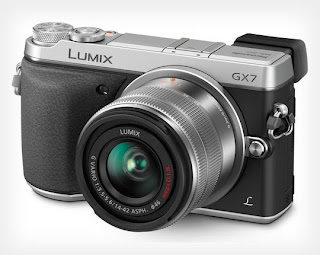Mirrorless cameras competing with Prosumer and Digital SLR cameras
You must have
seen various types of camera in the camera store or read the reviews on the
Internet or in magazine photography. Camera technology is more advanced, and we
made confused to choose compact-system cameras or digital SLR cameras. When
should we make the criteria, then you will see three kinds of cameras.
1. Compact-system camera: a camera with a
small sensor, a lens that has been integrated in a single system and setting
capabilities are limited
2. Digital SLR camera: a camera with a large sensor, there
is flexibility for the setting, and a full range of lens sizes as needed
(interchangeable lens)
3. Prosumer camera: compact camera with super-zoom lens
and there is enough flexibility which is almost equivalent to setting the
Digital SLR camera.
 |
| Touchscren feature on mirrorless camera. Image: petapixel.com |
The criteria
of these three have changed because since 2008, the world of digital cameras is
livelier with the presence mirrorless camera. New members in the world of
digital cameras and has a system similar to the workings of a Digital SLR
camera.
The camera is also equipped with the ability to change the lens
(interchangeable lens). But the mirrorless camera does not have reflective
mirror that reflects light from the lens to the viewfinder.
The loss of
mirror components causes the absence of an optical viewfinder (replaced by
electronic viewfinder) and allows the camera body to be thinner than a Digital
SLR. The result is the cameras with the body of a compact camera with the
“eyes” are big. Olympus and Panasonic are pioneers in the field of mirrorless
camera. Now you can find other mirrorless brands such as Ricoh GX, Samsung's NX,
Polaroid, Canon EOS-M, Sony NEX and others.
What factors
should be considered when selecting the mirrorless camera?
 |
| A new Panasonic GX-7 camera. Image: en.a5bary.com |
Design and interface
Mirrorless
cameras in general has a compact design with slight variations in the
dimensions of his body, but has a variety of variations on the buttons that
serve as an interface between the camera and the user.
Olympus PEN
and Panasonic G series have quite a lot of the interface (feels more like a
Digital SLR), while relying on internal Sony NEX and touch screen menu (feels
like a compact camera).
Sensor size
Mirrorless
camera sensor size is generally larger than those used in compact cameras, but
are generally smaller than Digital SLR. This will affect the ability to shoot
in lowlight conditions (high ISO). The cameras with larger sensors have better
ability to suppress noise on lowlight condition.
 |
| Ricoh GX 200. Image: cameras.webhostingoverview.com |
By order of
the size of the sensor Sony NEX, and Samsung NX Ricoh GX have big sensor with
APS-C size, followed by the Olympus PEN and Panasonic G with sensor 4/3, Nikon
1, which has been strengthened with the CX sensor and by the Pentax Q sensor
size 1 / 2.3 "(equivalent to compact-system cameras and Prosumer cameras).
Setting options
Mirrorless
cameras have the option of setting equivalent to entry-level DSLR enthusiast,
with a bonus of a variety of art-filter and on-board digital processing.
Features
Some series
Olympus PEN and Panasonic G has an image stabilizer. Average mirrorless camera
is equipped with face-detection. Nikon 1 autofocus ability with phase-detects
and contrast-detect.
Lens options
Olympus PEN
as a pioneer of this family have many options because most lenses can use mount
lenses with 4/3 is used by Olympus DSLR family E. By itself, the lens can be
used also by Panasonic G. Other Mirrorless
cameras rely on a wide range of lens adapters to be able to use a variety of
lenses. Combination with a vintage manual lens mirrorless body can be
accommodated by using the M42 adapter.
Accessories
Additional
accessories on the mirrorless camera are not as much on the DSLR camera. The
accessories include bias added flash, GPS, electronic viewfinder. Several types
of mirrorless cameras do not provide a port for additional accessories.
The
combination of compact dimensions, setting freely, and freedom of choice as an
herb sounds ideal lens for the photographer. What this means is that the DSLR
era has come to an end? For now, the answer is "no" or maybe
"not yet". There are at least two factors are still a barrier for
mirrorless cameras, namely:
 |
Olympus PEN E-P5. Image: news.xinhuanet.com
|
1. Sensor
size - in general is small, so that the resulting image in lowlight conditions
(high ISO) is still less than DSLR cameras, there are several types of
mirrorless cameras have managed to overcome the problem of low light.
2. Mirrorless
camera features and accessories are still not complete as DSLR cameras.
In addition
to various other limitations in terms of performance and features, but
mirrorless cameras also has some advantages that will be very beneficial if
used properly, for example when you are on vacation, family events, business
meetings and meetings with friends at the coffee shop. Now you can capture
every precious moment with mirrorless cameras and any photos you can upload to
social networking on the Internet with Wi-Fi facility.
Digital SLR
cameras, as well as compact-system cameras and Prosumer cameras are now getting
competition from mirrorless cameras, so the camera manufacturers have worked
hard to create a more attractive camera.



Comments
Post a Comment